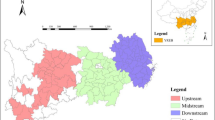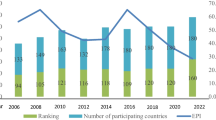Abstract
Environmental problems are endowed with the causal complexity of multiple factors. Traditional quantitative research on the influencing mechanism of environmental pollution has tended to focus on the marginal effects of specific influencing factors but generally neglected the multiple interaction effects between factors (especially three or more). Based on the panel data of 30 Chinese provinces between 2011 and 2020, this study employs fuzzy set qualitative comparative analysis (fsQCA) — which can provide a fine-grained insight into the causal complexity of environmental issues — to shed light on the influencing mechanism of environmental pollution. The results show that there are several different configurations of pollution drivers which lead to high pollution or low pollution in provinces, confirming the multiple causality, causal asymmetry, and equifinality of environmental pollution. Furthermore, the combination effect of advanced industrial structure, small population size, and technological advance is significant in achieving a state of green environment compared to environmental regulation factors. In addition, spatiotemporal analysis of the configurations indicates that strong path dependencies and spatial agglomeration exist in current local environmental governance patterns. Finally, according to our findings, targeted policy recommendations are provided.




Similar content being viewed by others
Data availability
The data used to support the findings of this study are available from the corresponding author upon request.
References
Bai Y, Song S, Jiao J, Yang R (2019) The impacts of government R&D subsidies on green innovation: evidence from Chinese energy-intensive firms. J Clean Prod 233:819–829
Bruno C, Reinhilde V (2006) In search of complementarity in innovation strategy: internal R&D and external knowledge acquisition. Oper Res 46:489–492
Chen Y, Wang Z, Zhong Z (2019) CO2 emissions, economic growth, renewable and non-renewable energy production and foreign trade in China. Renewable Energy 131:208–216
Cheng Z, Li L, Liu J (2020) The impact of foreign direct investment on urban PM2.5 pollution in China. J Environ Manag 265:110532
CMA (2021) Bulletin of atmospheric environment meteorology. C. M. Administration
David PA (1985) Clio and the economics of QWERTY. American Economic Review 75:332–337
David B, Charles R (2009) The case for qualitative comparative analysis (QCA): adding leverage for thick cross-case comparison. SAGE Publications Ltd, London, 222
Delery JE, Doty DH (1996) Modes of theorizing in strategic human resource management: tests of universalistic, contingency, and configurational performance predictions. Acad Manage J 39:802–835
Dess GG, Lumpkin GT, Covin JG (1997) Entrepreneurial strategy making and firm performance: tests of contingency and configurational models. Strateg Manag J 18(9):677–695
Dong K, Hochman G, Zhang Y, Sun R, Li H, Liao H (2018) CO2 emissions, economic and population growth, and renewable energy: empirical evidence across regions. Energy Economics 75:180–192
Douglas EJ, Shepherd DA, Prentice C (2020) Using fuzzy-set qualitative comparative analysis for a finer-grained understanding of entrepreneurship. J Bus Ventur 35(1):105970
Du KR, Cheng YY, Yao X (2021) Environmental regulation, green technology innovation, and industrial structure upgrading: the road to the green transformation of Chinese cities. Energy Econ 98:105247
Ehrlich PR, Holdren JP (1971) Impact of population growth. Science 171:1212–1217
Fiss PC (2011) Building better causal theories: a fuzzy set approach to typologies in organization research. Acad Manage J 54:393–420
Greckhamer T, Gur FA (2021) Disentangling combinations and contingencies of generic strategies: a set-theoretic configurational approach. Long Range Plann 54(2):101951
Greckhamer T, Misangyi VF, Fiss PC (2013) Chapter 3 the two QCAs: from a small-N to a large-N set theoretic approach. In: Fiss PC, Cambré B, Marx A (eds) Configurational theory and methods in organizational research, vol 38. Emerald Group Publishing Limited, pp 49–75
Greckhamer T, Furnari S, Fiss PC, Aguilera RV (2018) Studying configurations with qualitative comparative analysis: best practices in strategy and organization research. Strateg Organ 16:482–495
Guan D, Su X, Zhang Q, Peters GP, Liu Z, Lei Y, He K (2014) The socioeconomic drivers of China’s primary PM2.5 emissions. Environ Res Lett 9(2):024010
Hanif I, Gago-de-Santos P (2017) The importance of population control and macroeconomic stability to reducing environmental degradation: an empirical test of the environmental Kuznets curve for developing countries. Environmental Development 23:1–9
Huang GB, Zhang J, Yu J, Shi XP (2020) Impact of transportation infrastructure on industrial pollution in Chinese cities: a spatial econometric analysis. Energy Econ 92:104973
Hunt RA, Fund BR (2016) Intergenerational fairness and the crowding out effects of well-intended environmental policies. J Manage Stud 53:878–910
Jianqin M, Jingjing G, Xiaojie L (2010) Water quality evaluation model based on principal component analysis and information entropy: application in Jinshui River. J Resour Ecol 1(3):249–252
Krueger AB, Grossman GM (1995) Economic growth and the environment. Q J Econ 110:353–377
Laplante B, Rilstone P (2004) Environmental inspections and emissions of the pulp and paper industry in Quebec. J Environ Econ Manag 31:19–36
Li H, Zhang J, Wang C, Wang Y, Coffey V (2018) An evaluation of the impact of environmental regulation on the efficiency of technology innovation using the combined DEA model: a case study of Xi’an, China. Sustain Cities Soc 42:355–369
Li K, Fang L, He L (2019) How population and energy price affect China’s environmental pollution? Energy Policy 129:386–396
Li K, Fang L, He L (2020) The impact of energy price on CO2 emissions in China: a spatial econometric analysis. Sci Total Environ 706:135942
Liddle B, Lung S (2010) Age-structure, urbanization, and climate change in developed countries: revisiting STIRPAT for disaggregated population and consumption-related environmental impacts. Popul Environ 31:317–343
Lim L, Acito F, Rusetski A (2006) Development of archetypes of international marketing strategy, Journal of International Business Studies, Vol. Manag Int Rev 47:453–475
Linares I, Paulo A, Porto GS (2019) Patent-based network analysis to understand technological innovation pathways and trends. Tech Soc 59:101134
MEP (2017) The city air quality of China in 2016. M. o. E. Protection
Meyer AD, Tsui AS, Hinings CR (1993) Configurational approaches to organizational analysis. The Academy of Management J 36:1175–1195
Misangyi VF, Acharya AG (2014) Substitutes or complements? A configurational examination of corporate governance mechanisms. Acad Manage J 57:1681–1705
Pappas IO, Woodside AG (2021) Fuzzy-set qualitative comparative analysis (fsQCA): guidelines for research practice in information systems and marketing. Int J Inf Manage 58:102310
Park Y, Fiss PC, El Sawy OA (2020) Theorizing the multiplicity of digital phenomena: the ecology of configurations, causal recipes, and guidelines for applying Qca. Mis Quart 44:1493–1520
Pham NM, Huynh TLD, Nasir MA (2020) Environmental consequences of population, affluence and technological progress for European countries: a Malthusian view. J Environ Manage 260:110143
Ragin CC (1989) The comparative method - moving beyond qualitative and quantitative strategies - Ragin, CC. Soc Forces 67(3):827–829
Ragin, CC. 2000. Fuzzy-set social science. University of Chicago Press Economics Books.
Ragin C (2008) Redesigning social inquiry: fuzzy sets and beyond. University of Chicago Press
Rihoux B, Ragin CC (2009) Configurational comparative methods: qualitative comparative analysis (QCA) and related techniques. Sage, Thousand Oaks
Ritter H, Schopf M (2014) Unilateral climate policy: harmful or even disastrous? Environ Resource Econ 58:155–178
Rutten, R, 2020. Applying and assessing large-N QCA: causality and robustness from a critical realist perspective. Sociological Methods & Research published online.
Shahbaz M, Loganathan N, Muzaffar AT, Ahmed K, Ali Jabran M (2016) How urbanization affects CO2 emissions in Malaysia? The application of STIRPAT model. Renew Sustain Energy Rev 57:83–93
Shen N, Peng H (2021) Can industrial agglomeration achieve the emission-reduction effect? Socioecon Plann Sci 75:100867
Shen F, Liu B, Luo F, Wu C, Chen H, Wei W (2021) The effect of economic growth target constraints on green technology innovation. J Environ Manage 292:112765
Tan H, Fan Z (2019) Technical management ability, attention allocation and local government website construction-a configuration analysis based on TOE frame [in Chinese]. Management World (monthly) 9:81–94
Wagemann S (2012) Set-theoretic methods for the social sciences. Cambridge University Press
Wang H, Wei W (2020) Coordinating technological progress and environmental regulation in CO2 mitigation: the optimal levels for OECD countries & emerging economies. Energy Economics 87:104510
Wang XZC, Zhang Z (2019) Pollution haven or porter? The impact of environmental regulation on location choices of pollution-intensive firms in China. J Environ Manage 248:109248
Wang X, Zhou DQ (2021) Spatial agglomeration and driving factors of environmental pollution: a spatial analysis. J Clean Prod 279:123839
Wang P, Wu WS, Zhu BZ, Wei YM (2013) Examining the impact factors of energy-related CO2 emissions using the STIRPAT model in Guangdong Province, China. Appl Energy 106:65–71
Wen Q, Chen Y, Hong J, Chen Y, Shen Q (2020) Spillover effect of technological innovation on CO2 emissions in China’s construction industry. Build Environ 171:106653
Woodside AG (2013) Moving beyond multiple regression analysis to algorithms: calling for adoption of a paradigm shift from symmetric to asymmetric thinking in data analysis and crafting theory. J Bus Res 66:463–472
Yeh J-C, Liao C-H (2017) Impact of population and economic growth on carbon emissions in Taiwan using an analytic tool STIRPAT. Sustainable Environment Research 27:41–48
Yu S, Zheng S, Zhang X, Gong C, Cheng J (2018) Realizing China’s goals on energy saving and pollution reduction: industrial structure multi-objective optimization approach. Energy Policy 122:300–312
Zhang P (2020) Target interactions and target aspiration level adaptation: how do government leaders tackle the “Environment-Economy” nexus? Public Adm Rev 81:220–230
Zhang W, Xu H (2017) Effects of land urbanization and land finance on carbon emissions: a panel data analysis for Chinese provinces. Land Use Policy 63:493–500
Zhang W, Liu Y, Feng K, Hubacek K, Wang J, Liu M, Jiang L, Jiang H, Liu N, Zhang P, Zhou Y, Bi J (2018a) Revealing environmental inequality hidden in China’s inter-regional trade. Environ Sci Technol 52:7171–7181
Zhang Z, Hao Y, Lu Z-N, Deng Y (2018b) How does demographic structure affect environmental quality? Empirical evidence from China. Resour Conserv Recycl 133:242–249
Zhang G, Zhang N, Liao W (2018c) How do population and land urbanization affect CO2 emissions under gravity center change? A spatial econometric analysis. J Clean Prod 202:510–523
Zhao J, Jiang Q, Dong X, Dong K (2020) Would environmental regulation improve the greenhouse gas benefits of natural gas use? A Chinese Case Study Energy Eco 87:104712
Zheng D, Shi M (2017) Multiple environmental policies and pollution haven hypothesis: evidence from China’s polluting industries. J Clean Prod 141:295–304
Zheng Y, Peng J, Xiao J, Su P, Li S (2020) Industrial structure transformation and provincial heterogeneity characteristics evolution of air pollution: evidence of a threshold effect from China. Atmos Pollut Res 11:598–609
Acknowledgements
The authors wish to express their sincere gratitude to the Fundamental Research Funds for the Central Universities (no. 2021CDJSKJC20 and 2021CDJSKCG28), the Natural Science Foundation of China (grant no. 72071022 and 71801023), Chongqing Science & Technology Commission (no. cstc2020jscx-msxmX0036) for funding this research project.
Author information
Authors and Affiliations
Contributions
Yang Chen: conceptualization, methodology, writing — original draft, and writing — review and editing. Jingke Hong: conceptualization and writing — review and editing. Miaohan Tang: data analysis and resources. Yuxi Zheng: visualization. Maoyue Qiu: software. Danfei Ni: writing — review and editing.
Corresponding author
Ethics declarations
Ethics approval
Not applicable.
Consent to participate
Not applicable.
Consent for publication
Not applicable.
Conflict of interest
The authors declare no competing interests.
Additional information
Communicated by Baojing Gu.
Publisher’s note
Springer Nature remains neutral with regard to jurisdictional claims in published maps and institutional affiliations.
Electronic supplementary material
Below is the link to the electronic supplementary material.
Appendix
Rights and permissions
Springer Nature or its licensor holds exclusive rights to this article under a publishing agreement with the author(s) or other rightsholder(s); author self-archiving of the accepted manuscript version of this article is solely governed by the terms of such publishing agreement and applicable law.
About this article
Cite this article
Chen, Y., Hong, J., Tang, M. et al. Causal complexity of environmental pollution in China: a province-level fuzzy-set qualitative comparative analysis. Environ Sci Pollut Res 30, 15599–15615 (2023). https://doi.org/10.1007/s11356-022-22948-3
Received:
Accepted:
Published:
Issue Date:
DOI: https://doi.org/10.1007/s11356-022-22948-3




